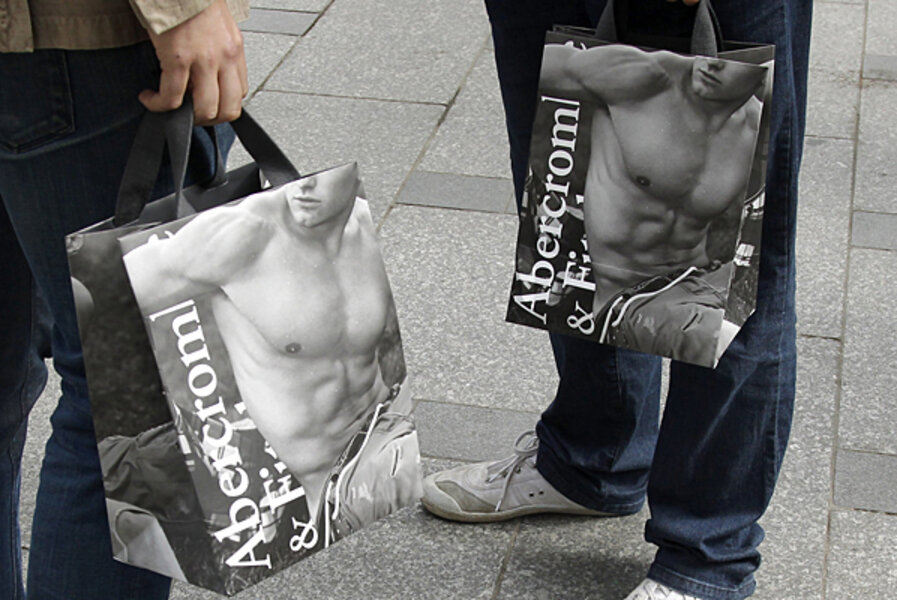Mike Jeffries wants no fat customers at A&F. Bad business?
Loading...
Abercrombie & Fitch is no stranger to controversy. Outside of its client base of upper middle class high schoolers, the high-end clothier might be better known for its scandalous catalogues and checkered history with hiring and labor regulations than it is for its jeans or tank tops. The retailer’s latest fracas? Its CEO, Mike Jeffries, stands accused of discriminating against plus-sized shoppers.
It started with author and retail analyst Robin Lewis, who claimed in an interview last week with Business Insider that Mr. Jeffries “doesn’t want larger people shopping in his store, he wants thin and beautiful people.” He went even further, suggesting that Jeffries “doesn't want his core customers to see people who aren't as hot as them wearing his clothing. People who wear his clothing should feel like they're one of the cool kids,” Lewis told Business Insider.
Those charges are nothing new, and Abercrombie & Fitch has lent them plenty of support. For one, the chain doesn’t carry plus sizes: Its women’s clothes only run from Extra Small to Large (no XL or XXL) and its jeans only go to a size 10 (plus sizes generally start at size 14).
Jeffries has been “unapologetic about this exclusionary marketing forever,” says Steve Hoch, a marketing professor at the University of Pennsylvania’s Wharton business school in Philadelphia. "They have a very targeted, narrowly defined [customer] in age and what type of body, even what ethnicity you are, and they’ve been able to hold onto it.”
What’s more, the CEO has made the point publicly that his store is for a very specific type of client, and that those who don’t measure up should probably shop elsewhere.
“In every school there are the cool and popular kids, and then there are the not-so-cool kids. Candidly, we go after the cool kids,” Jeffries told Salon in 2006. “We go after the attractive all-American kid with a great attitude and a lot of friends. A lot of people don't belong, and they can't belong. Are we exclusionary? Absolutely.”
Weeding out everyone but that perfect, popular, pretty shopper isn’t limited to sizing. There’s the prices: A&F is far more expensive than its competitors for the 18-22 demographic, like American Eagle and H&M (both of which sell XXL and plus sizes). It’s notorious for its lack of sales and discounts, even coming under fire for its refusal to lower prices or offer discounts in the thick of the Great Recession – a move that many analysts blamed for 10 straight months of double digit sales declines in 2009 and the closure of over 150 stores. It has since refocused most of its development energies overseas, and had a strong fourth quarter in 2012, but its stock price is still a third below its pre-recession highs. The company's latest earnings results are scheduled to be released next week.
Abercrombie’s hiring practices, too, have a history of being exclusionary, to the point that it’s caused the company some legal problems. In 2004, the company reached a $4 million settlement in a class-action lawsuit charging that it discriminated against minorities in its hiring procedures; the suit required A&F to put several policies in place to encourage building a more diverse workforce.
But apart from the colorful interviews and legal troubles, Jeffries’ targeted marketing is merely a less polite version of what most retail brands do, anyway, Mr. Hoch points out. “What they’re doing is just a little more extreme than what every brand does, he says. “Aeropostale, American Eagle, Urban Outfitters. There is a fairly specific identity that each brand is trying to offer up to younger consumers.”
When the brand was hugely popular, in the late ‘90s and early 2000s, that strong brand identity was an advantage for A&F, which doesn’t “get caught up in not being willing to sacrifice certain customers.” He points to Gap as a telling counter-example, a now-declining brand that tried too hard to be all things to all people. “Abercrombie signals something about how you want people to look at you. The Gap doesn’t.”
What’s less clear is whether any retailer can afford to ignore the plus-sized demographic of shoppers. According to a 2008 survey from the market research firm Mintel, the most frequently worn women’s size in the US is a 14, and an estimated 67 percent of Americans are considered plus-sized. Yet their retail market share is disproportionally limited. Few brands, other than Lane Bryant, exclusively target plus-sized shoppers, and until recently, stores like American Eagle and Chico’s that sold bigger sizes “didn’t talk about it,” Hoch says.
That’s starting to change. H&M recently hired a plus-sized model as the face of its new swimwear line. Old Navy and Levi Strauss & Co., The Limited, and other retailers are slowly rolling out lines and stores specifically for plus-sized customers.
So, will Abercrombie & Fitch soften its targeted marketing to include a bigger customer (and customer base)? Jeffries didn’t budge on price during the recession, so it’s unlikely he’ll budge on size, though his competitors are.






